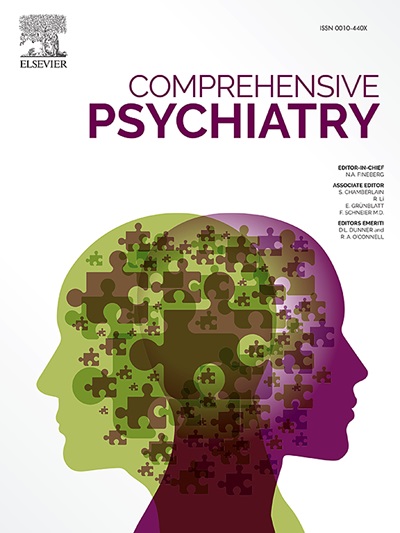Quo vadis DSM-6? An expert survey on the classification, diagnosis, and differential diagnosis of body-focused repetitive behaviors
IF 4.2
2区 医学
Q1 PSYCHIATRY
引用次数: 0
Abstract
Background
Many conditions we now call body-focused repetitive behaviors (BFRBs) have been subject to research for several decades, most notably trichotillomania and skin picking. However, the American Psychiatric Association did not combine these conditions into a single category, body-focused repetitive behavior disorders (BFRBDs), until the fifth edition of the DSM (2013). Several aspects of the disorder remain uncertain and controversial. For example, ongoing debate surrounds which specific conditions fall under this diagnostic category and how to best differentiate BFRBs from conditions such as nonsuicidal self-injury (NSSI). The current article presents results from a survey of experts' opinions on diagnostic criteria, with the goal of refining the diagnostic criteria.
Method
We contacted experts on BFRB via various sources and invited them to complete an online survey on the phenomenology, classification, and differential diagnosis of BFRB. We also inquired about possible alternative syndrome labels (e.g., body-focused habit).
Results
Data from the final sample of 50 experts demonstrates that most experts agree with the present classification of BFRB/BFRBD as an obsessive-compulsive and related disorder and recommend retaining the labels BFRB or BFRBD. The experts considered the following conditions BFRB, with an agreement of over 60%: trichotillomania, skin picking, dermatophagia, nail biting, and lip-cheek biting. Mixed results emerged for awake bruxism and thumb sucking in adults. Only a minority regarded night bruxism and knuckle cracking as BFRB. To differentiate BFRB from NSSI, the experts noted that the motive behind the urge (self-harm/injury versus release of tension) should be considered. Analyses of a sub-sample of experts with at least six years of clinical and/or research experience yielded results compatible with those of the entire sample.
Discussion
The survey supports the usefulness of the BFRBD diagnostic entity. However, some criteria require further refinement. Future editions of the DSM should more explicitly delineate which conditions qualify as BFRB. Furthermore, it is important to give more attention to the primary motivation behind BFRB to distinguish it from NSSI and potentially from stereotypic movement behavior.
DSM-6又如何?关于以身体为中心的重复行为的分类、诊断和鉴别诊断的专家调查。
背景:数十年来,我们一直在研究许多我们现在称之为 "以身体为中心的重复行为(BFRBs)"的疾病,其中最著名的是 "嗜毛癖 "和 "抠皮肤"。然而,美国精神病学协会直到第五版 DSM(2013 年)才将这些病症合并为一个单一的类别,即肢体专注重复行为障碍(BFRBDs)。该疾病的一些方面仍存在不确定性和争议。例如,围绕哪些具体病症属于这一诊断类别,以及如何将 BFRBs 与非自杀性自伤(NSSI)等病症进行最佳区分,一直存在争议。本文介绍了专家对诊断标准的意见调查结果,旨在完善诊断标准:方法:我们通过各种渠道联系了 BFRB 方面的专家,邀请他们就 BFRB 的现象学、分类和鉴别诊断完成一项在线调查。我们还询问了可能的替代综合征标签(如身体关注习惯):结果:来自 50 位专家的最终样本数据显示,大多数专家同意目前将 BFRB/BFRBD 划分为强迫症及相关障碍,并建议保留 BFRB 或 BFRBD 的标签。专家们认为以下几种情况属于 "BFRB",同意率超过 60%:嗜毛癖、抠皮肤、嗜皮癖、咬指甲和咬嘴唇。对于成人的清醒磨牙症和吸吮拇指,结果不一。只有少数人将夜间磨牙症和指关节皲裂视为 "磨牙秽语综合征"。专家们指出,要区分 "磨牙阻断 "和 "非自残",应考虑冲动背后的动机(自残/伤害还是释放紧张)。对至少有六年临床和/或研究经验的专家子样本进行分析后得出的结果与整个样本的结果一致:讨论:调查支持 BFRBD 诊断实体的实用性。然而,某些标准需要进一步完善。未来版本的 DSM 应更明确地界定哪些情况符合 BFRB。此外,必须更加关注 BFRB 背后的主要动机,以将其与 NSSI 和可能的刻板动作行为区分开来。
本文章由计算机程序翻译,如有差异,请以英文原文为准。
求助全文
约1分钟内获得全文
求助全文
来源期刊

Comprehensive psychiatry
医学-精神病学
CiteScore
12.50
自引率
1.40%
发文量
64
审稿时长
29 days
期刊介绍:
"Comprehensive Psychiatry" is an open access, peer-reviewed journal dedicated to the field of psychiatry and mental health. Its primary mission is to share the latest advancements in knowledge to enhance patient care and deepen the understanding of mental illnesses. The journal is supported by a diverse team of international editors and peer reviewers, ensuring the publication of high-quality research with a strong focus on clinical relevance and the implications for psychopathology.
"Comprehensive Psychiatry" encourages authors to present their research in an accessible manner, facilitating engagement with clinicians, policymakers, and the broader public. By embracing an open access policy, the journal aims to maximize the global impact of its content, making it readily available to a wide audience and fostering scientific collaboration and public awareness beyond the traditional academic community. This approach is designed to promote a more inclusive and informed dialogue on mental health, contributing to the overall progress in the field.
 求助内容:
求助内容: 应助结果提醒方式:
应助结果提醒方式:


